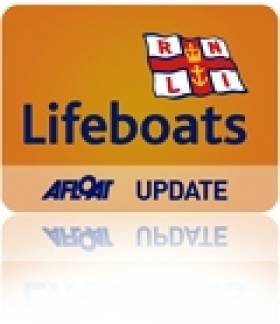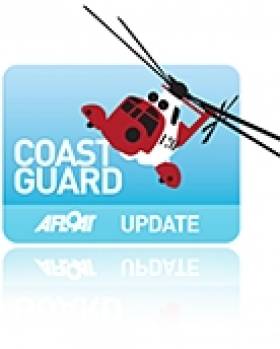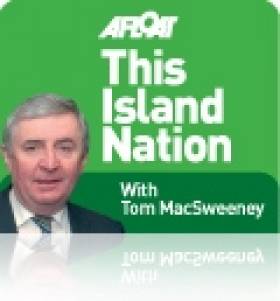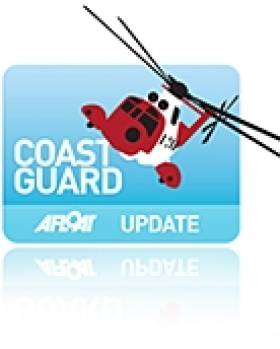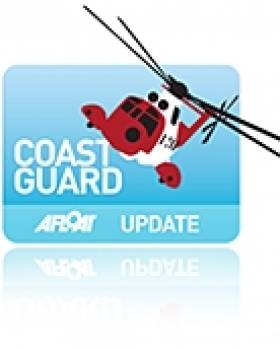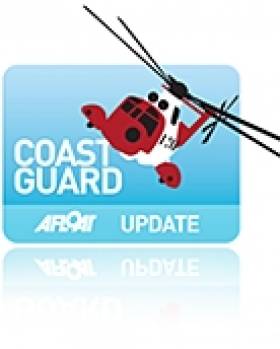Displaying items by tag: Coast Guard
Abandon Ship! The Rescue of the Crew of Wolfhound
#wolfhound – Abandon ship!!! Complete with its insistent screamers (that's exclamation marks to you and me), it's such a hoary old nautical cliché that when it happens, you expect awesome background music to roll, with the blackest of black clouds overhead tearing apart to reveal some majestic and divine portent.
But the reality these days is that with well-established International Laws of the Sea in place, and time-tested global rescue procedures working effectively supported by the latest in basic emergency radio communication, once it has moved beyond a life-and-death situation with the rescue achieved, it very quickly becomes a humdrum matter of filing reports, completing forms, and submitting to official enquiries.
Such routine is important for everyone, and not least the rescued. It puts their experiences into perspective, it makes them realise that what has happened to them is not horribly unique, and it gives them a reasonable feeling that while they have suffered an acute personal setback, perhaps it can now be of some benefit to others. By slipping into established post-rescue formalities and analysis, the process of mental and physical recovery can be quietly begun.
Obviously the situation is completely different if there has been loss of life. But happily, in the matter of the rescue of the crew of four from the Irish-owned Swan 48 Wolfhound 70 miles off Bermuda on the morning of Saturday February 9th 2013, apart from one non-acutely wounded hand, there was no serious injury involved. So we can now examine how a very attractive project to take part in the sun-filled RORC Caribbean 600 Race in a fine 12-year-old Swan 48 newly-purchased in New England, and subsequently sail the boat home across the Atlantic to Ireland after cruising the Caribbean, became so totally unravelled in an extreme winter storm in the Gulf Stream.
Alan McGettigan (52) has made his career in the oil and gas exploration business. One of the founders of successful frontline operator Petroceltic, his work has taken him to harsh and volatile places which, if they weren't already dangerous to be in at the time, inevitably became dangerous with their added strategic significance when his prospecting was successful. It was a working life outside normal comfort zones, so as a sailing enthusiast – when he could get the time – he also pushed the limits of the possibilities in cruising.
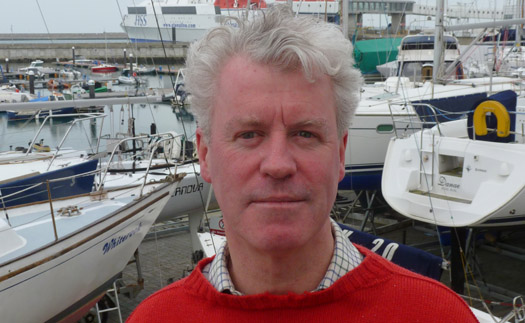
Alan McGettigan in Dun Laoghaire 27/02/13 Photo: W M Nixon
A dozen or so years ago, he bought a Ron Holland-designed Swan 43 which he called Wolfhound. Though time was initially limited, six years ago he began a long-term cruise aimed at circumnavigating western Europe, beginning with a west-east transit of the Mediterranean in which – unusually – he focused in the early stages on the coast of North Africa.
Being very much part of the Dun Laoghaire sailing community, he has like-minded friends – many of them boat-owners themselves – to make up a crew panel on which he could draw for congenial ship's company, people who in turn were enthused by his interest in going to unusual places. Despite the turmoil in the region, with each succeeding season Wolfhound found herself getting further east, and in time she explored the Black Sea in some detail before – in the summer of 2011 – she shaped her course into the Danube.
But after the worst drought in a hundred years, the great river's levels were so low that Wolfhound's draught prevented them getting any further than fifty kilometres upriver, so they returned to the Black Sea coast, and arranged to lay the boat up afloat for the winter in the attractive Romanian port of Constanta. But then in November, too late to move to another port, Alan had a call from the harbour that they required Wolfhound to be lifted out and laid up ashore, for which the yard would provide the cradle.
Although he preferred her to be afloat in the sheltered little marina, he flew out and supervised the transfer ashore. Then in January the yard was in contact again to say that an extreme winter storm was moving south from Siberia, and there was a danger that boats ashore on the quay would be engulfed in snow and ice. But the weather was already so bad that Constanta airport was closed down. So Alan could do nothing but await the worst as the yard emailed him photos which showed Wolfhound disappearing under her own private iceberg which eventually weighed more than ten tonnes. The cradle collapsed, and the boat sustained further serious damage in falling on her side under yet more snow and ice.
Although badly damaged, she was repairable, yet she would only be acknowledged as a proper Swan if the repairs were done by Nautor Swan themselves in Finland. But that process with its long transportation would be prohibitively expensive. The insurers preferred a yard they'd found in Bulgaria. Eventually, the stalemate was broken with a deal in June, the insurers paying up the insured value, and keeping the damaged boat.
So Alan found himself boatless in June 2012, but with an unexpected accumulation of significant boat-buying resources, as he sold up his shareholding in Petroceltic in 2012. The world was his oyster, or rather his Swan, and he toyed with the idea of an attractive readily-available Swan 60 in the south of France, and a Swan 651 in the UK.
But this resulted in a certain thoughtful sucking-in of the breath among his regular crew panel. They pointed out that if he was seduced into going above a certain size, their cosy all-friends-together-as-equals arrangement would almost certainly be disrupted by the need to carry professional crew, particularly if the boat was going to be moving around exotic and distant locations.
Those of us who mess about in smaller boats are happily untroubled by this critical change of boat management requirements above a certain size. Indeed, it's a problem for which most of us would have scant sympathy. But it is very real for those who have the means and inclination for a larger boat in which they can really cover the ground and get comfortably, if somewhat impersonally, to distant places, if they're prepared to go with the potentially disruptive presence of professional crew making them feel like passengers on their own boat.
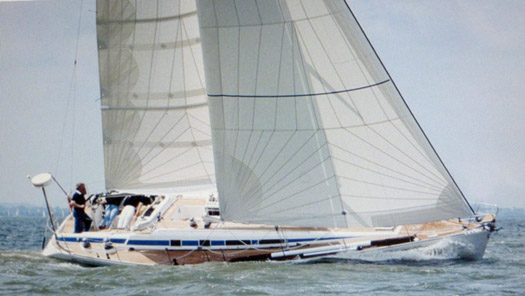
"A modern Moonduster". The Frers-designed Swan 48 is nearly 50ft long, and is an up-dated glassfibre sister of Denis Doyle's famous Moonduster
By September 2012, however, things were back on track with the location of a 12 year old Swan 48 in Connecticut. Originally designed by German Frers in 1994, the boat is actually just a matter of inches under 50ft LOA, which made her the equivalent of an up-dated production version of Denis Doyle's legendary Moonduster. As one of the senior members of the eclectic McGettigan Crew Panel had sailed many successful races with The Doyler on The Duster, it was reckoned that this was all as it was meant to be, as it offered the additional prospect of an immediate season or two in the Caribbean with a boat which was of a size to be still manageable without a professional crew.
This also offered the possibility of racing the Caribbean 600 in February 2013, an attractive idea as the boat came with a formidable wardrobe of sails. But if that aim was to be comfortably fulfilled, the boat had to be ready to sail south to the Caribbean in November, when fleets of boats make the journey south from New England as soon as the hurricane season is over.
However, with Superstorm Sandy wreaking havoc in the New York coastal area in September, it was impossible to bring things to fruition as quickly as hoped. Despite the shared language, buying a boat in the US can be much more difficult than buying one in Europe. And as you finally do close the deal, you are already discovering that boats in America, while seemingly identical to their sister-ships in Europe, can often carry very different equipment.
So the programme slipped, but by late November Alan was doing sea trials on Long Island Sound with a surveyor, and by early December he had been given a favourable report, and negotiations were drawing towards a conclusion through a broker with an owner - never personally met - who lived in another distant American state.
Finally, with the seller faced with the exigencies of the end of the tax year on December 31st, the deal was concluded on that last day of 2012. Meanwhile, back in Ireland over the Christmas/New Year holiday, the crewing arrangements were firmed up between those who were to do the delivery passage in late January/early February from Connecticut to the Caribbean via Bermuda, those who then wished to do the Caribbean 600 Race on February 18th, and those who would cruise the islands afterwards.
It was a very busy time with the new boat, now re-named Wolfhound, being transferred to Irish ownership with details like the IRC rating being re-issued by the ISA. But on 25th January Alan and three long-time shipmates arrived in Connecticut knowing that the weather prospects were bad with Snowstorm Nemo developing over the northeast United States, but equally knowing that a favourable weather window would follow it.
However, they knew there were some days of work to be done in any case before they could sail, and by the time that was completed the economy of Connecticut had benefited from the Wolfhound campaign by a significant amount. As expected, a new top-of-the-range Viking liferaft had to be installed, but less clearly expected was the necessary acquisition of a new Zodiac inflatable tender and outboard, and completely inexplicable was the need to install a new Charger/Inverter, the original having disappeared. The boat, in other words, was not precisely as Alan remembered her from the last time he'd seen her in early December, but with goodwill all round she was made ready for sea.
Thanks to friends in the Cruising Club of America, Alan and his crew had a briefing session with people well used to sailing the 650 miles to Bermuda at 1215 on Saturday 2nd February, and at 1530 hrs they headed out round the northeast end of Long Island and shaped their course parallel with the American coast towards Cape May in order to slip between weather systems and get in to more clement conditions as quickly as possible, for though the winds were favourable northerlies and easing after the storm force winds of Nemo, the temperature was minus 8.
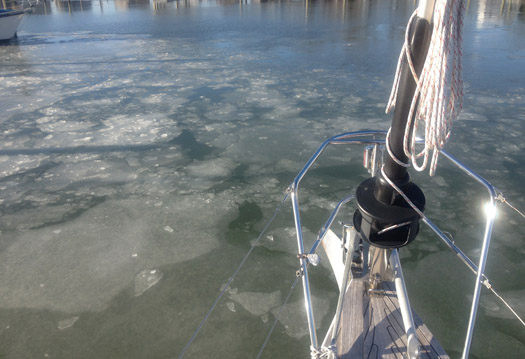
Getting through the ice departing from Connecticut on the afternoon of Saturday February 2nd. As darkness drew on, the temperatures plunged. Photo: Alan McGettigan
In such conditions, it was so cold that they motored with only the mainsail set, and put in watches of only half an hour. But progress was good and through Day 2 (Sunday February 3rd), everything was going according to plan, they were finding their weather window, and it was even getting slightly – just very slightly – warmer, as by now the wind was easterly, though as it was 30 knots with some gusts to 50 knots it was by no means the "champagne sailing" they'd been promising themselves once they got down to Cape May.
By Monday morning conditions permitted one hour watches and soon they were sailing properly, but there was concern about a new weather system developing to the eastward in the tail of Storm Nemo. However, satisfactory progress was being maintained and they were able to move up to two hour watches with half hour rotations. The going was good, but that was as good as it was to get. In order to keep up battery power, they tried to put the new Mastervolt Charger/Invertor into service on the remote setting, but the indicator light failed to show. This was serious. They were halfway through the passage to Bermuda, but knew that unless someone aboard suddenly discovered his own previously unrevealed genius as an electrical and electronics engineer, by Day 4 (Tuesday February 5th), all systems except the engine would be down through lack of power – this duly happened at 0350hrs on the Tuesday.
They were now halfway between the American mainland and Bermuda, but with the frequently changing wind by this time from the west, it didn't make sense to try to beat for the Chesapeake as the nearest mainland all-weather port of refuge, even if Bermuda is a place difficult of access. So they pressed on, but later on the Tuesday the engine failed to re-start. It was found that it could be run intermittently, and as it had been serviced before leaving, the suspicion was that grunge in the fuel tank – the boat had been effectively out of commission for more than a year – was causing fuel blockages, so they made do without the motor, as any use would only make the blockage problem worse, and maybe damage the engine.
Their situation was seriously unpleasant, for although cooking had been by gas, the top-of-the-line American marine cooker relied on an electrically-powered safety switch for its ignition. So for the time being they endured cold food – mostly breakfast cereals and fruit – and resisted the temptation to cut the gas line and by-pass the safety connection to the stove, though without heating of any sort and only cold food, the effect on morale was dire.
By now they were getting into very bad weather again with huge seas and rising winds, and on Day 5 (Wednesday February 6th) the furled headsail (it was the Number 4) was simply shredded by the strength of the wind despite being rolled. But conditions had eased enough the following day to get the remains down and cleared from the forestay.
Despite everything, they were getting near Bermuda, for even with their problems they had averaged 5.5 knots from Connecticut. But the weather was once again deteriorating, and now their sense of being cut off from all assistance was exacerbated by the discovery that their hand-held VHF was completely discharged, even though it had been fully charged ashore prior to departure, while their location was too remote for personal mobiles to be of any use.

So near and yet so far.....Wolfhound's route towards Bermuda
So with all systems down, visibility very poor and conditions deteriorating, with the vessel getting a horrendous pounding with a couple of knockdowns and chaotic dislocation below to such a degree that it was safer to remain on deck, the only navigational information available was through a single iPad which was already down to 15% power. But even if they could find their way the final fifty miles to Bermuda, they had no engine power to get through the intricate reefs and St George's Channel.
Throughout all this, Alan recalls that he never heard a voice raised in anger or frustration – he had shipmates to cherish. And that's what he did. He cherished them. Much and all as he'd had great hopes for his new boat, he decided that the risks to life and limb in trying to make the final rock-strewn miles to Bermuda were simply too great. It was a choice of putting his friends' lives at great risk, or abandoning ship. It was no contest. He activated the EPIRB at 1530 hours on Friday February 8th.
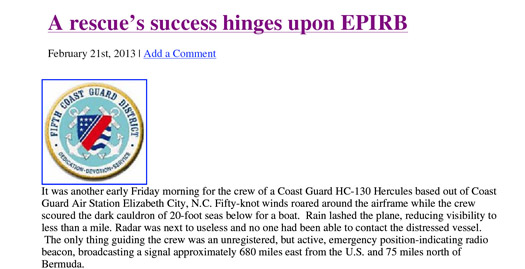
The offiial US Coastguard report into the rescue is downloadable below as a PDF document
As the American authorities couldn't immediately trace the registration of the EPIRB (see downloadable PDF of Coastguardnews below) they didn't at first know what they were looking for, but that Friday night, Wolfhound was located in darkness by a US Coastguard C130 Hercules aircraft from Norfolk, Virginia, which dropped emergency supplies and more importantly indicated to them that help was on the way. Meanwhile Bermuda MRCC instructed two ships in the area, the Empire Champion and the Tetien Trader, to alter course towards Wolfhound.
The Empire Champion was unladen, which made manoeuvring in the extreme weather difficult, but the fully-laden Greek ship Tetien Trader arrived at dawn on Saturday February 9th and did the job. Floating deep, she provided an almost rock-like base onto which the crew of Wolfhound, which was alongside with long warps fore and aft, could be hauled aboard by the sheer brute strength of eight men pulling on a heavy warp which the Irish crew had to tie round themselves using a bowline knot.
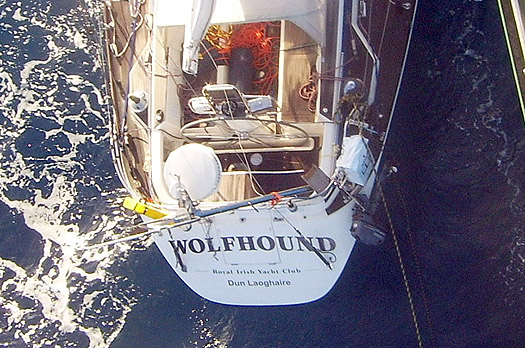
The chaos of Wolfhound's cockpit seen as she lay briefly alongside Tetien Trader during the rescue. Photo: Alan McGettigan
Throughout all this, in a cruel twist the sky had temporarily cleared and there was even a hint of sunshine before the next wave of bad weather closed in again later in the morning, During the rescue, the yacht was rising and falling fifteen to twenty feet up the steel side of the ship, but after the crew had been hauled to safety, the extreme conditions soon snapped the warps holding Wolfhound alongside, and she drifted away. She was not seen to sink, as some reports have suggested, and might even be still out there, alone on the ocean. Her crew meanwhile headed east across the Atlantic on the Tetien Trader, and were landed at Gibraltar on Wednesday February 20th.
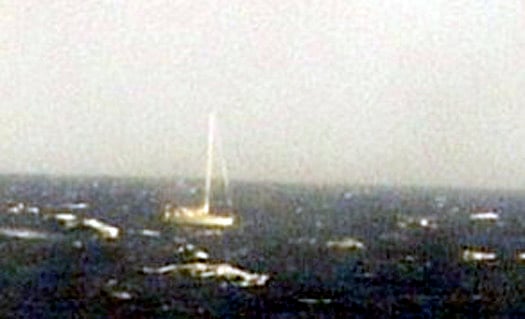
Last glimpse of Wolfhound from Tetien Trader before the weather closed in again. Photo: Alan McGettigan
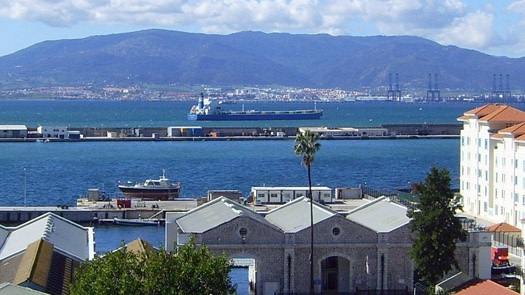
Journey's end. Tetien Trader in Gibraltar on February 20th. Photo: Alan McGettigan
As for what might be learnt from this sad story, that can be analysed in due course, but all that can be said this morning is that it could have been much worse. No lives were lost, nobody was seriously injured. In extremis, the right and proper priorities were observed. Life can go on. Indeed, it was going on almost immediately. On the Transatlantic passage on the Tetien Trader, Declan Hayes was moved to pen some poetry:
Wolfhound (the adventures of Alan, Morgan, Declan & Tom)
Dublin, Boston, then Bermuda bound
To start our journey on the new Wolfhound
Tortola, Antigua, Azores and home
Cutting through the Atlantic foam
It was oh so very, very cold
As we set out on our journey bold
Dreaming of the warm Gulf Stream
And the Caribbean sun on our beam
But that was never going to be
As we battled wind and heavy seas
All power went and food was low
As we were battered about in the merciless blow
We signalled help by satellite
But no help came until the night
The drone of engines in the sky
Then searchlights allowed them us to spy
By daylight two ships had answered our call
But we could not board due to swell and squall
Persistence paid and one by one
We were hoisted aboard, it was no fun!
Wolfhound crashed against the mighty hull
Then broke her lines with a mighty pull
She drifted past the stern abeam
The end of Alan's epic dream
Aboard the ship, the Tetien Trader
Our lives intact, disappointment faded
A nicer crew you could not have chosen
The captain, cook, not least the bo'sun
Ten days we spent on that good ship
Before they let us off at the Rock of Gib
A trip I doubt we will ever forget
So very different from travelling by jet!
The moral of the story is plain to see
You never know what's going to be
Life is precious and full of hope
A boat's just plastic, metal and rope
Time will pass and memories fade
But the experience is there, forever made
Another part of who you are
Another story for the bar!
Comment on this story?
We'd like to hear from you on any aspect of this blog! Leave a message in the box below or email William Nixon on [email protected]
Fishing Vessel Crew Rescued off Campbeltown Loch
#rescue – Four fishermen were rescued by Campbeltown RNLI Lifeboat in the early hours of this morning after their fishing vessel began taking on water off Campbeltown Loch.
The vessel broadcast a mayday message at 2.30 am this morning reporting that it was taking water and required immediate assistance. The Campbeltown RNLI lifeboat was requested to launch and the Campbeltown Coastguard Rescue Team was sent to the scene. A Navy rescue helicopter from Prestwick was also scrambled.
Gary Young, Watch Manager at Belfast Coastguard stated
"Campbeltown Lifeboat was quick to arrive on scene and safely transferred all four fishermen from their stricken vessel, with no reported injuries. The fishing vessel remains aground and will be assessed at first light."
Fishermen Rescued after Vessel Sinks off County Down Coast
#coastguard – Two fishermen have been rescued after the fishing vessel Snowdonia sank approximately 12 miles east of Kilkeel Harbour on the County Down coast.
Belfast Coastguard received a call from the fishing vessel Tribute reporting that they had recovered two fishermen from the water. The RNLI lifeboat from Kilkeel and the Irish Coast Guard Search and Rescue helicopter were sent to the scene. The crew of Kilkeel Inshore Lifeboat were quickly on scene and provided first aid until the arrival of the Irish Helicopter.
The two crew were airlifted to Daisy Hill Hospital, Newry where they are currently being assessed.
Gary Young, Watch Manager Belfast Coastguard, said: "This incident has again proved the importance of wearing a lifejacket and having it maintained to a high standard.
"I would like to pass on my thanks to the professionalism of the lifeboat and helicopter crews."
Additional reporting from RNLI:
The volunteer lifeboat crew with Kilkeel RNLI were today involved with a local fishing vessel and the Irish Coast Guard helicopter from Dublin in the rescue of two fishermen after the boat they were in sank off the Down coast. The men were ten miles from Kilkeel when the boat started to take in water and the alarm was raised.
Kilkeel RNLI received the call for assistance at 10.30am this morning (Tuesday 23 October 2012) and immediately launched and made their way to the scene. When the lifeboat crew arrived the vessel had sank and the two men had been taken onboard another fishing vessel, which was in the vicinity and able to respond to the callout. The fishermen had been in the water for a few minutes before they were pulled to safety and were feeling the effects of the freezing cold water.
A lifeboat crewmember from Kilkeel RNLI was transferred onto the vessel where they administered first aid and oxygen to the freezing men. On the arrival of the Dublin Coast Guard helicopter the two men were airlifted onboard and taken to Daisy Hill Hospital in Newry.
Commenting on the callout Roy Teggerty, Kilkeel RNLI Lifeboat Operations Manager said, "The two fishermen were extremely lucky. Thanks to the quick action of the passing fishing vessel along with the Kilkeel RNLI lifeboat and Dublin Coast Guard the men were recovered from the water very quickly and received first aid. I wish the men a full recovery from their ordeal.
Isle of Man Kayak Girl Brought to Safety
#rescue – A 7-year-old girl was rescued from the bay at Derbyhaven yesterday afternoon after being swept offshore by southwesterly winds.
The Marine Operations Centre based at the Isle of Man contacted Liverpool Coastguard at 1.26 pm to let them know that they been alerted to a young child being blown offshore in a sea kayak. The mother of the child had swam approximately 100 metres out to try and rescue the girl but was not able to reach her and was forced to turn back.
Liverpool Coastguard requested the launch of the Ronaldsway Airport Inshore Rescue Boat and the Port St Mary RNLI lifeboat, along with sending the Castletown Coastguard Rescue Team. Concerned that the child might get swept out of the bay, Liverpool Coastguard also contacted the HSC Manannan Ferry and asked them to keep a visual of the child at a safe distance to ensure she was not swept out further.
Two other sea kayakers on scene attempted to rescue the child but all three ended up on the rocks. The Ronaldsway Airport Inshore Rescue Boat then brought the girl and her kayak back to shore.
Volunteers in the Castletown coastguard team spoke to the parents of the girl and gave some safety advice about the dangers of offshore winds.
Paul Parkes, Liverpool Coastguard Watch Manager said:
"When undertaking any leisure activities on the water with young children we would always recommend that they are accompanied by a capable adult. As this incident shows, offshore winds can be extremely hazardous to children in inflatables or any craft where they are not able to make it back to shore unaided."
Rambler Crew Thankful, A Story of Two Vessels, Our Paralympians and Cork's New Pilot Boat
The Rambler Crew thank Valentia Radio for saving their lives in the Fastnet Race, but Coast Guard management wants to shut the station .... My story of two vessels ... John Twomey's Parlaympian achievements ... Cork gets a new Pilot Boat and ... trying to make ship-boarding pilot ladders safer ... There's a lot about boats in this week's TIN ..... Read on ....
SAVING LIVES MATTERS MOST – NOT FINANCIAL CUTBACKS
August 15 this year marked a very special day for the crew of the yacht Rambler 100 – they were still alive and they celebrated that fact – and they sent from New York an Email to the staff of Valentia Radio Coastal Station in Kerry. Coast Guard management in Dublin has a proposal to shut down the station and transfer its work to Dublin, to the constituency of the Minister for Transport, as a support station to the main Dublin base!
On August 15 the Rambler 100 crew Emailed to the staff at Valentia Island Maritime Radio Station:
"Today marks the one-year anniversary of our unfortunate accident during the Fastnet Race. Each Rambler crew member has his own story of what happened during this time of distress, however, the one thing that we share is the gratitude we feel for the Valentia Island Coast Guard. The professionalism of the Valentia crew and the diligence in alerting all authorities for our successful rescue is the reason we are here to share in the celebration of survival today. Tonight at 5.42 p.m. New York time the Rambler team will gather together and raise our glass to the sea and send out our thanks to our new friends in Ireland. Gratefully yours, Wendy, George and the Rambler 100 Crew."
Not much more needs to be said about the importance of Valentia Island Coastal Radio Station and its continued operation. It has a long history of saving life at sea in addition to its other operations.
I have asked for an interview with the Director of the Coast Guard Chris Reynolds, to find out exactly what is going on with the management proposals and why they want to centralise operations in Dublin. One proposal is that a support base to the national centre in Dublin should be located Blanchardstown, which just happens to be in the constituency of Minister for Transport Leo Varadakar who will have the final decision to make on the future of the coastal radio stations at Valentia and Malin and who has already indicated that "tough" decisions will be taken.
Again, the question has to be raised, as it was when then Minister Dempsey sought to close Waterford SAR rescue station – How much is a life worth?
TWO BOATS – TWO STORIES
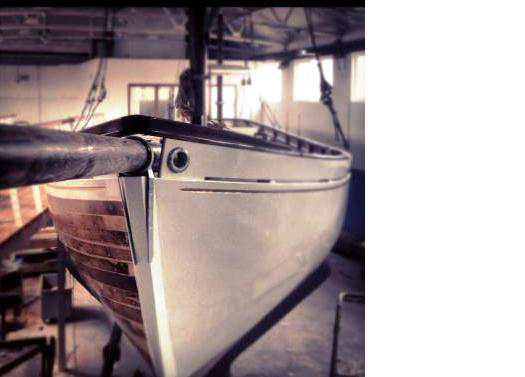
Asgard I pictured above, Celtic Mist in main image
Two boats, part of the Irish maritime scene in years past, are back in public – Asgard 1 and Celtic Mist – one ashore, the other afloat.
I was in the National Museum at Collins Barracks in Dublin when the historic ketch of Erskine and Mollie Childers went on exhibition after a five-year restoration project. It will be a permanent reminder of how the marine sphere was central to the formation of this Republic. Asgard looks superb. There was a lot of controversy over whether she should be restored or put to sea again, but the right decision has been made to conserve her ashore. The exhibition is open free-of-charge and worth seeing.
The second vessel, Celtic Mist, is the motor-sailing ketch of Charlie Haughey which his family donated to the Irish Whale and Dolphin Group. I was asked to re-dedicate it to its new role as a research vessel and did so on Sunday at Kilrush Marina, where hundreds watched the ceremony. I talked to Conor Haughey who told me: "They have rejuvenated her. She was getting old and tired and it would have been a shame if she rotted away rather than going to sea again. The boat was very important to my father. It has great family memories."
Onboard, Charles Haughey's cabin has been dismantled, including the bath and double berth and several bunks built instead for researchers who will track whales and dolphins and carry out other maritime research. Much of the eight-month refurbishment work was done by IWDG volunteers, with some contractors and financial assistance from the Clare Leader organisation and other supporters.
Despite all the controversy surrounding Haughey, as IWDG Director Simon Berrow said, getting the boat was a major benefit and came in the 21st year of its existence. In government Haughey had declared Ireland's waters a whale and dolphin sanctuary and Dr.Berrow said this should be followed by a
similar "pan-European designation" of EU waters. The Celtic Mist will provide a platform for finding out more about whales and other marine life off Ireland, he said.
JOHN TWOMEY AND THE IRISH PARALYMPIAN SAILORS

Irish Sonar Team
Kinsale Yacht Club member John Twomey is leading his crew into his tenth consecutive Paralympics, a magnificent achievement for the 57-year-old sailor. He will Skipper the Sonar, Ireland's only sailing entry, with crew Anthony Hegarty and Ian Costelloe. Sailing will be in the testing waters of Weymouth Bay on the south coast of England where the Olympic events were also held.
For the past three and a half decades he has been one of Ireland's most consistent and successful performers at the Paralympic Games. John is already the holder of Paralympic medals, won prior to his sailing career in the discus event - bronze in 1984 and gold at Seoul 1988. He also competed in table tennis before his transition to sailing, winning silver in the team event at Arnhem in 1980. Before moving to the three-man Sonar keelboat he sailed with Amy Kelleher in the mixed SKUD18 event at Beijing 2008, finishing tenth with a score of 75 points.
In preparing for this year's Paralympic John, Anthony and Ian were 7th in the World Disabled Sailing Championships in Florida and have been practising intensively off Kinsale over the past few weeks.
I met him at Kinsale YC and he was hopeful about their prospects:
"Tough waters in Weymouth, but with the experience of the past few months, particularly in the world championships we are well prepared."
John is from Ballinhassig, has represented Ireland more times than any other Olympic or Paralympic athlete. He is involved in sailing courses in Kinsale for people with disabilities where up to 30 sailors with a wide range of physical, intellectual and sensory disabilities go sailing every Saturday.
In Paralympic Sailing, three medal events feature one, two and three sailors per boat, respectively. All events consist of nine separate races with one point for first, two for second and so on, the same as in Olympic sailing. The winner has the lowest points total at the end of the nine races.
John's crew mates are 42-year-old Anthony from Mallow and 24-year-old Ian from Killorglin in County Kerry. Both are both amputees. John introduced Anthony to sailing seven years ago. He works as a software developer for Core International and has represented Ireland on several occasions. He is also a member of Kinsale Yacht Club.
Ian also sails out of Kinsale YC and will be making his first appearance at the Paralympic Games.
Paralympics Ireland CEO and Chef de Mission for the Irish Team, Liam Harbison, said there has been tremendous preparation, co-ordination and management of the Irish Team. "It's time for us to make a return on the faith and investment placed in us – we aim to deliver."

From left: John Twomey, Ian Costelloe and Anthony Hegarty.
NEW PILOT BOAT IN CORK
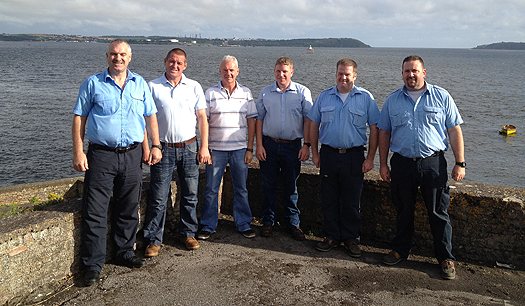
Cork Pilot Boat Crew
Cork Port has a new pilot boat. 'Failte' was built by Safehaven Marine and replaces 'Sonia' which has been in service for 14 years. Safehaven Marine is a Cork -based company, employing 25 staff in Little Island and Youghal. Since the company was founded in 1998. They have supplied pilot boats to countries from Scandinavia to the Middle East and are one of Europe's leading manufacturers of GRP pilot boat.
There are eight full-time crew, six of them pictured here – L to R: Ron Randalls, Carl Randalls, Gerry Moran, George Norris, Con Crowley and Keith Ryan. (Two were on holiday when the photo was taken.) The boat is an Interceptor 48 with two Volvo D13 engines, 600 hp each.
Cork pilot boats undertake in excess of 3,000 services per annum to vessels of all types including cruise ships and cargo vessels, according to the port company.
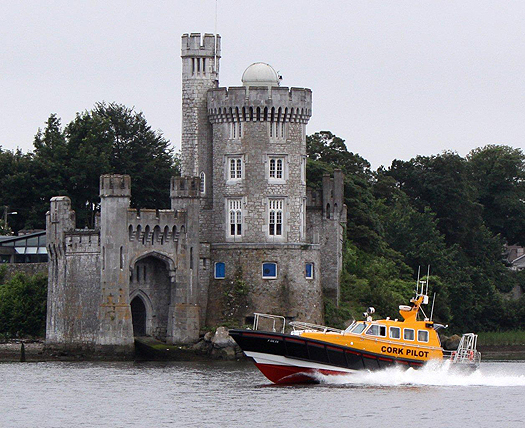
MAKING PILOTING SAFER
The International Maritime Pilots' Association and the International Chamber of Shipping have joined forces to update a brochure aimed at shipping companies and seafarers to ensure that ladders used for pilot transfers are safe and always rigged correctly.
The revised brochure – 'Shipping Industry Guidance on Pilot Transfer Arrangements' – is supported by a wide range of other international shipping bodies. It takes account of the latest amendments to the Safety of Life at Sea Convention (SOLAS) concerning pilot ladders, which came into effect on 1 July 2012.
IMPA Secretary General, Nick Cutmore, said: "Pilots continue to lose their lives as a result of accidents while boarding or disembarking from ships, and many more have been seriously injured."
ICS Secretary General, Peter Hinchliffe, added: "Some common causes of accidents still appear to be defects in the structure of the ladder treads or ropes, or a lack of a proper securing of the ladder to the ship."
An electronic copy of the IMPA/ICS brochure can be downloaded from the IMPA and ICS websites.
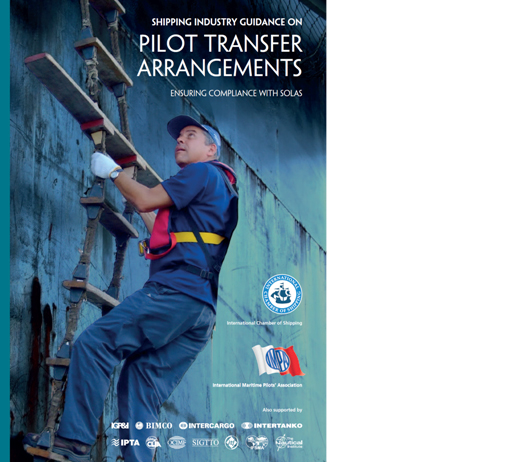
New Pilot Boarding Advice
--------------------------------------------------------------------------------------------------------
Email your comments on items in TIN develop maritime discussion to: [email protected]
Follow me for more maritime news and comment on Twitter: @TomMacSweeney
And on Facebook – THIS ISLAND NATION page
Lifejackets Save Lives - UK Coast Guard
#LIFEJACKETS – There were 95 maritime deaths in the UK in the last five years which might have been prevented if those involved had been wearing a lifejacket or buoyancy aid. These figures were collated following the annual meeting of the Casualty Review Panel in March.
The panel looked at fatal maritime incidents for 2011 and, where there was sufficient information, assessed whether it was probable, possible or unlikely that the person involved could have been saved had they been wearing a lifejacket or buoyancy aid.
In 2011, the panel judged that of the incidents that they considered, it would have been appropriate for 18 people to have worn some form of buoyancy. Of these, 13 would probably or could possibly have been saved had they been wearing a lifejacket or buoyancy aid. Between 2007-11 the panel considered 120 fatalities and in 95 of these cases a life could probably or might possibly have been saved had the person involved been wearing a lifejacket or buoyancy aid.
Commercial fishing and angling are the two riskiest activities where lives might be saved by buoyancy-wear, according to the figures collated by the panel over the last five years.
Transferring between your vessel and the shore is particularly hazardous. Twelve people died boarding or alighting during 2011 and the risk is increased further following alcohol consumption. Eight of these twelve had been drinking before they returned to their vessel. Transferring between a vessel and the shore is a situation where one would not normally be expected to wear a lifejacket or buoyancy aid. Further research will be undertaken regarding this issue.
Operation Underway to Remove Fuel from Grounded Vessel
#COAST GUARD – The operation to remove the remaining 24,000 litres of fuel oil, along with oily water and other hazardous materials from the grounded vessel 'Carrier' was completed yesterday evening.
The vessel, which ran aground on 4 April near Llanddulas in North Wales, remains aground and is resting against concrete dolosse blocks on the beach close to the North Wales Expressway (A55). The owners of the vessel have declared it a Constructive Total Loss.
On Saturday, PGC Demolition, the same company who were awarded the contract to remove the fuel oil from the vessel, were also awarded the contract to remove the wreck of the vessel. Their proposals to cut the vessel up on site and remove it for recycling have been approved by the Deputy to the Secretary of State's Representative for Maritime Salvage and Intervention, with work expected to start tomorrow and last for a period of up to ten weeks.
County Down Coast Guard is Recognised for Rescue
Coastguard Rescue Officer Keith Campbell has been recognised for his part in the rescue of four people trapped in water on an incoming tide in Dundrum Bay, County Down on 9 July 2011.
Four teenagers found themselves cut off by the tide and up to their shoulders in water while walking from Ballykinler to Dundrum. They called 999 and whilst the rescue teams were on their way to the scene, Keith, a former Coastguard Rescue got his dinghy into the water and rescued the teenagers from the water.
In total the efforts of five individuals are to be recognised by the award of the Chief Coastguard’s Commendations 2011.
Ian Deakin from the Newhaven Coastguard Rescue Team received his award, for saving the life of a 19 year old man from heavy seas at Newhaven, on 8 June 2011.
The team was called to Splash Point near Seaford in East Sussex following a 999 call reporting a man face down in the water. Newhaven Coastguard Rescue Team was first to arrive on scene and, realising that time was of the essence, Ian went out and quickly brought the man to shore where he was resuscitated.
The Chief Coastguard’s Commendations have also been awarded to:
Peter Thomson of MRCC Aberdeen for his 25 years of outstanding contribution to the work of HM. Coastguard;
John Kirkpatrick, CRO, for his part in the rescue of two adults and six children who were stranded on a rising tide in Dundrum Inner Bay, County Down on 27 April 2011;
Adrian Sanderson, DSO, for his part in the recovery of a person from the water off Cleethorpes on 19 November 2011.
Rod Johnson, Chief Coastguard said:
"Peter, Ian, John, Adrian and Keith have acted in the highest traditions of the service.
"In commending these officers I’d also like to take the opportunity to recognise the outstanding work done by all of our officers every day and often in the face of adversity. Well done, and thank you."
Damaged Cargo Ship Remains Aground
The cargo ship 'Carrier', which ran aground at 8.15 last night (Tuesday) at Raynes Jetty in Llanddulas remains hard aground in the same location with damage to its starboard side. A quantity of marine gas oil has leaked from the vessel.
The 'Carrier' has been holed in three places on the starboard side. It's reported that the port side, where the fuel tank is located, is intact.
Officers from the Maritime and Coastguard Agency's Counter Pollution and Salvage branch are working with all agencies on plans to remove the fuel as soon as possible.
Vessel Aground at Llanddulas
At 8.15 last night Liverpool Coastguard received a distress call from the cargo ship 'Carrier' telling them they had run aground at Raynes Jetty, Llanddulas.
A strong gale was blowing and a five metre swell was reported. Because of the location of the grounding Holyhead Coastguard coordinated the rescue. All seven of the Polish crew were taken uninjured from the ship by two rescue helicopters (the first from RNAS Prestwick, the second from RAF Leconfield).
The A55 was closed to allow the rescue services safe access to the vessel. Coastguard Rescue teams from Rhyl and Llandudno offered assistance to the rescued crew whilst the RNLI lifeboats from Llandudno and Rhyl launched.
The vessel is now resting against concrete dolosse* blocks on the beach at Llanddulas, which runs adjacent to the A55. Coastguard Rescue Officers, North Wales Fire and Rescue Service, Ambulance and Police are currently on scene with the Highways Agency. Salvage and counter pollution experts will be on site in the morning.





























